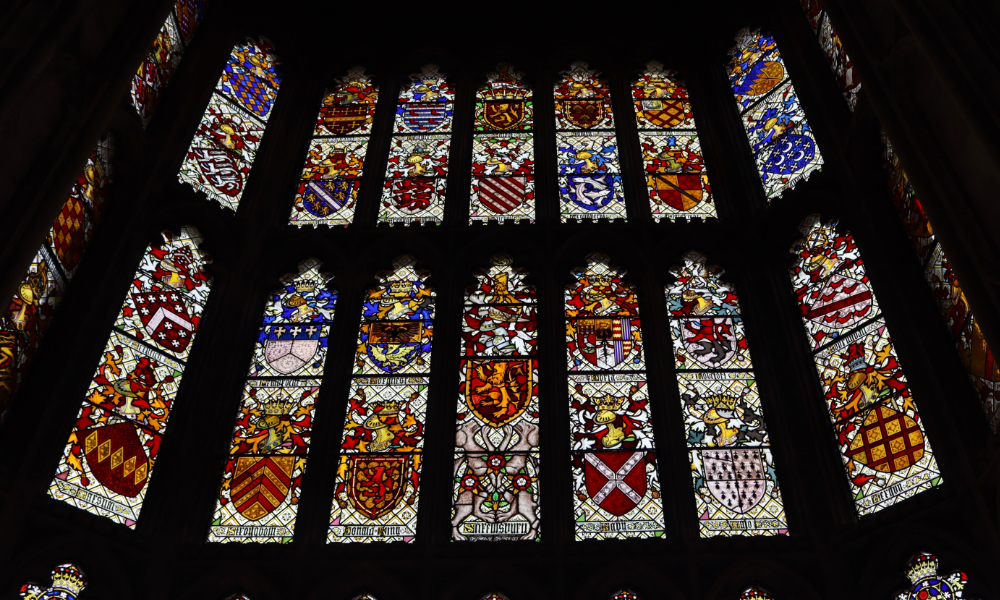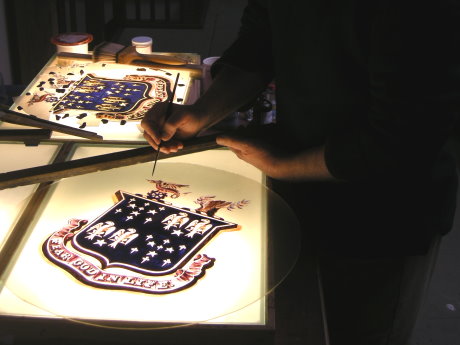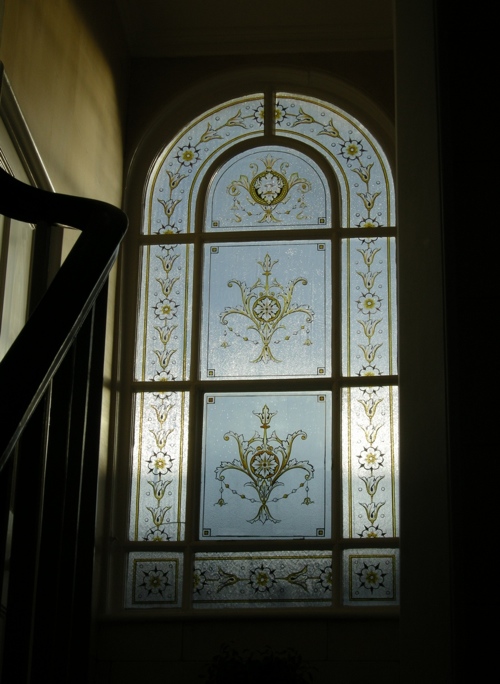
We are glass painters, not administrators or archivists. That’s why we don’t accept work which requires an unreasonable amount of paper-work. We will only do as much documentation as is strictly required by common sense. This is because paper-work costs time and money, which is often better spent on actual work; and conservation is itself expensive, because it is so painstaking.
“Only as much documentation as required …”
Indeed, we once used a 20-page report to demonstrate how an ancient window’s repairs were best tackled in situ.
This short report saved our client many tens of thousands of pounds in removal and re-installation costs, plus it avoided the expense of repairing all the invariably ensuing damage.
Our own fee was perhaps 5% of the alternative procedure – a clear case of justified paper-work, which is always fine. It’s unnecessary paper-work we won’t indulge in.
Restoration
We are skillful imitators, copiers, forgers and mimics.
Here you see David, re-painting the coat of arms from Dinder Hall:
It arrived at our studio in 479 small and jumbled pieces, all wrapped like this (with many fragments missing):

Dinder Hall – how the coat of arms arrived
And this is how it left us – or rather what its forgery looked like when we returned it to its owners:

Dinder Hall – the replacement coat of arms when it was ready to leave the studio
Another time, we travelled to the South of France on account of this gorgeous window you see here:

Journey to the South of France
There was extreme damage to several sections like this:

South of France – broken stained glass
… which meant forgeries like this:

South of France – example of an excellent copy
Difficult, time-consuming, and costly.
But now you can look through the original window onto the Bay of Nice and you would never know there once had been such damage.
The great dining hall at Alton Towers
We recently restored Pugin’s lost masterpiece – 18 magnificent stained glass windows and 9 tops – for the great dining hall at Alton Towers.
Here’s a before and after photograph of the middle window:

Here are most of the windows:

We re-painted the 18 windows and 9 tops from top to bottom on the back, so that, from the front, the stained glass blazes like it did when it was first installed in 1856.
Auction
Many clients send us items they’ve bought at auction which we then conserve or restore as close-to-new as possible. Here is one such worthwhile piece of re-leading-in-progress:

From a Paris auction house to Williams & Byrne to a house in Switzerland
When this window and its other half arrived, the nineteenth-century glass was full of cracks. Modern factory-made glass was unacceptable. Therefore we employed a glass blower to make new mouth-blown glass in the necessary colours.
Right now we are restoring many windows for a mansion on the shores of Lake Geneva. The client is confident he can trust us (rather than another studio) to do this work for him.
Agreed – this doesn’t say much about our marketing …
The owners of this erstwhile badly damaged window here had been searching for 12 years before they found us:
12 years: it made us realise our communication was not good enough, so we improved it.
Good work vs. bad
The point about good restoration work is, it shouldn’t call attention to itself (whereas bad work sticks out). Here are some comparisons between good work we did and bad work we replaced: click here for good vs. bad stained glass restoration.
Your next step
If you have stained glass conservation or restoration we can help with, send us some good photos.
Let us look at the photos first and then (once we’re well informed about the style and kind of damage) we’ll arrange a time to talk with you.

